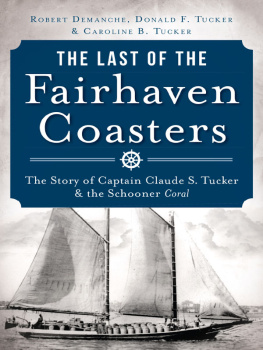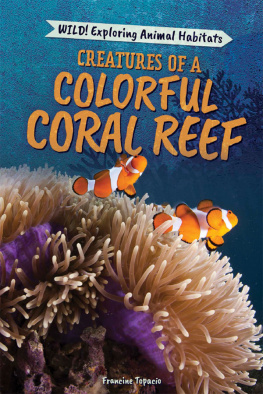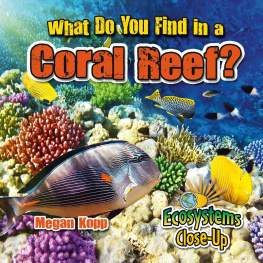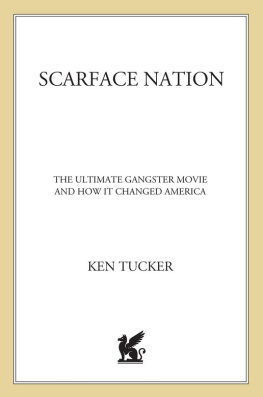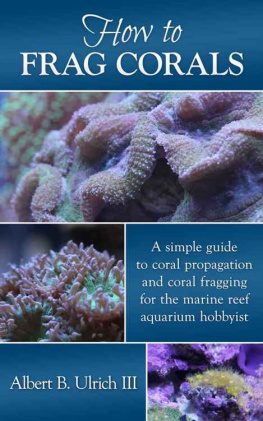
Published by The History Press
Charleston, SC 29403
www.historypress.net
Copyright 2013 by Robert Demanche, Donald Tucker and Caroline Tucker
All rights reserved
Front cover: The Coral loaded with gasoline for Nantucket, 1920s. Collection of Donald F. Tucker.
First published 2013
e-book edition 2013
Manufactured in the United States
ISBN 978.1.61423.927.7
Library of Congress CIP data applied for.
print edition ISBN 978.1.60949.945.7
Notice: The information in this book is true and complete to the best of our knowledge. It is offered without guarantee on the part of the author or The History Press. The author and The History Press disclaim all liability in connection with the use of this book.
All rights reserved. No part of this book may be reproduced or transmitted in any form whatsoever without prior written permission from the publisher except in the case of brief quotations embodied in critical articles and reviews.
To the captains and crews
of the coasting schooners of old.
Their hard work and dedication
help build our nation.
Contents
Preface
For many years, Captain Claude S. Tucker would entertain his wife and children with stories of his schooner days aboard the Coral. His son Donald found these looks back into history captivating, and in later years, he began to think others might feel likewise. It became Donalds goal, then, to set his fathers stories down in print. In that way, future generations might get a flavor of the coasting life. Readers would also come to know the story of how at least one coasting schooner and the family that owned her continued to operate until near the very end of the age of commercial sail.
Three people contributed to the writing of this book. Donald delivered the first of many talks on the subject to a Mystic Seaport audience in 1986. In 1994, Caroline (Carrie) Tucker helped her father-in-law assemble photographs, transform his raw lecture notes into narrative and shape the work into early book form. I came on board two years later to develop their topic into a self-published book. Encouraged by that books success, we now have launched an expanded and thoroughly rewritten take on Captain Tucker and the Coral. As we like to say, we have overhauled our original work from stem to stern.
The story we tell is part as told to and part historical research. We were fortunate to be able to draw valuable information and insights from recorded interviews of Captain Tucker and of three others who spent some of their early years aboard the Coralsons Bill and Donald and Bill Talbot. Other first-person sources include Captain Byron Hallocks Forty Years Windjammer and George Gales Log of the Coral.
A hurricane is pivotal to the story of Captain Tucker and the Coral. The story of a different hurricane will help convey my wish for the readers of our book. In the late summer of 2011, some friends and I had tickets for a concert at a nearby music venue. The venue was of the theater-in-the-round under a big circular outdoor tent variety. Unlike the hurricane in Captain Tuckers story, people knew about the impending 2011 storm well in advance, and management cancelled the show beforehand.
I learned of the cancellation by an email in which the author cheerfully signed off with, Dont forget to button down the hatches! Maybe it was nautical navet or just a subconscious slip. Either way, I got a kick out of it. I hope that, whether or not you know that one should batten down the hatches, you will learn something interesting from our book and have an entertaining time doing so.
Robert Demanche
Fairhaven, Massachusetts
March 5, 2013
Acknowledgements
The authors are especially grateful to Kathryn Eident for her editorial suggestions during this projects early stages; to both Dave Mitchell and Ted Lorentzen for their insights and suggestions for the manuscript; and to Dave Mitchell for his scanning and photography work.
The Tuckers lost almost all photographs, papers and other memorabilia relating to the Coral during the hurricane of 1954. We are deeply indebted to the following people and organizations that helped us reconstruct the story of Captain Tucker and the Coral: Captain Biff Bowker for his interview of Captain Tucker, and Bill Tucker and Bill Talbot for providing interviews; Bill Talbot; Charlie Sayle; Paul C. Morris; George Keyes; Captains Doug and Linda Lee; Ray Covill; Steve Crowley; Helen Tucker Davidson; Edna K.S. Demanche; Philip Arthur Hartley III; Barbara C. Whalen; John Wojcik; Joe Alcobia and the U.S. Coast Guard Auxiliary; the Fairhaven Office of Tourism; the Freetown Historical Society; and the State Library of Massachusetts for providing photographs and images.
We are grateful to Robert Sisler, historian for the Port Jefferson Historical Society, for directing us to Jeffrey T. Hallock, who brought Forty Years Windjammer to book form; Kathleen Brunelle and Stephen Cole for their suggestions on publishing; Captains Robert Douglas, Doug and Linda Lee and Ray Williamson for their interest and encouragement; and Deborah Chormicle for assistance with the bibliography. Thank you, also, to Professor Len Travers and Margaret Lowe for their timely suggestions.
We also wish to thank the archivists and librarians at the following institutions for doing the work necessary to maintain and make available the information that researchers find so valuable: the Millicent Library, the New Bedford Whaling Museum, the New Bedford Free Public Library/Special Collections and Archival Collections, the Thomas Crane Public Library, Cape Cod Community College and the U.S. Army Corps of Engineers.
And finally, thank you to all our family and friends.
CHAPTER 1
The Hurricane
Not long after waking, Bill Tucker climbed up the short ladder leading from the cabin and stepped out onto the deck of his fathers schooner. He thought to himself, This is starting out to be a beautiful day. In a few hours, Bills father, Captain Tucker, would join him in Newport Harbor, and the two mariners would head to the island of Nantucket aboard their schooner loaded with two hundred barrels of paving oil. It was September 21, 1938, and the Great Depression was beginning its tenth year. Although there werent many cars on Nantucket, this paving oil would help turn some old, unimproved road on the island into a street with a solid surface.
Their vessel was named the Coral. She could carry fifty tons of cargo, not a very large amount for a coasting schooner. Then again, out of all the coasters that ever sailed, she was one of a very few that still existed and could bring in at least a modest income. With 125 of the fifty-five-gallon metal barrels arranged to fill every possible space on deck and another 75 stored below, the Coral moved through the water so smartly that her captain could rightly claim, She was a corker under sail.
A shipbuilder named Captain Henry Hallock built the Coral in 1878 in Port Jefferson on Long Islands northern shore. He built her as a sloop, a vessel with one mast, so that he could carry cargo on the sound. Within six months, though, he felt he would benefit by converting the Coral into a two-masted coasting schooner, a somewhat similar type of vessel.
The rebuilt Coral was family owned, like many other two-masted coasters. These wooden sailing vessels were relatively easy to handle and maneuver. They were wide, for holding lots of cargo on deck, yet they could easily travel up into the numerous shallow inlets along the coast. They earned their keep by transporting various types of bulk freight. If they hauled lumber on one trip, they might haul oysters, vegetables, cordwood, brick or any of a number of goods and amenities on the next.
Next page
